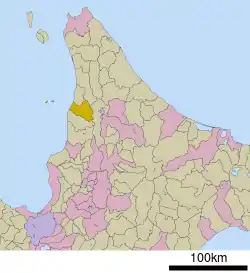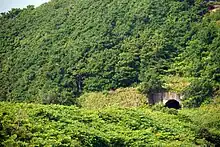Haboro, Hokkaido
Haboro (羽幌町, Haboro-chō) is a town located in Rumoi Subprefecture, Hokkaido, Japan.[1]
Haboro
羽幌町 | |
|---|---|
Town | |
 Flag  Emblem | |
 | |
 Haboro Location in Japan | |
| Coordinates: 44°21′N 141°42′E | |
| Country | Japan |
| Region | Hokkaido |
| Prefecture | Hokkaido (Rumoi) |
| District | Tomamae |
| Area | |
| • Total | 472.49 km2 (182.43 sq mi) |
| Population (2016) | |
| • Total | 7,338 |
| • Density | 16/km2 (40/sq mi) |
| Time zone | UTC+09:00 (JST) |
| Climate | Dfb |
| Website | www |
As of September 2016, the town has an estimated population of 7,338. The total area is 472.49 km2. The town also administers the two islands of Yagishiri and Teuri.
Haboro was officially designated a town in 1921. The villages of Teuri and Yagishiri were merged into Haboro in 1955 and 1959, respectively.[1]
Etymology
The name of the town is from the Ainu language, but of uncertain origin. Haboro may have originated with the Ainu language word hapuru, meaning "a soft sound", or haporopetsu, meaning "the basin of a large river".[1]
In Japanese, the name of the town is written with ateji, or kanji characters used to phonetically represent native or borrowed words. The first, 羽, means "feather" or "wings", and the second, 幌, means "curtain" or "cloth".
Geography
Haboro faces the Sea of Japan. Much of the area of the town is within the Teshio Mountains, and much of the town is protected as a national forest.[1] Mount Pisshiri is the highest point in the city at 1,032 metres (3,386 ft). Two rivers cross the town: the Haboro and the Chikubetsu.
Islands
The municipality of Haboro includes two sparsely populated islands in the Sea of Japan.
- Yagishiri Island (23 kilometres (14 mi)), population 273, is located northwest of Haboro Bay, and is known for its dense forests.[2][3]
- Teuri Island, population 366, is located 3.5 kilometres (2.2 mi) west of Yagashiri, and the two islands are separated by the Musashi Channel. Teuri covers 5.5 square kilometres (2.1 sq mi), and is protected as a bird sanctuary.[4][5]
Neighboring municipalities
- Rumoi Subprefecture
- Kamikawa Subprefecture
Climate
Haboro has a humid continental climate (Köppen climate classification Dfb) with warm summers and cold winters. Precipitation is high throughout the year; the months from August to December are wetter than the rest of the year. The highest temperature recorded was 34.4 °C (94 °F) on August 1, 2021.[6] The coldest temperature ever recorded was −26.4 °C (−15.5 °F) on 27 January 1923.[7]
| Climate data for Haboro (1991−2020 normals, extremes 1921−present) | |||||||||||||
|---|---|---|---|---|---|---|---|---|---|---|---|---|---|
| Month | Jan | Feb | Mar | Apr | May | Jun | Jul | Aug | Sep | Oct | Nov | Dec | Year |
| Record high °C (°F) | 8.6 (47.5) |
9.9 (49.8) |
15.9 (60.6) |
24.3 (75.7) |
28.2 (82.8) |
30.9 (87.6) |
34.2 (93.6) |
34.4 (93.9) |
33.9 (93.0) |
24.1 (75.4) |
20.1 (68.2) |
12.4 (54.3) |
34.4 (93.9) |
| Mean maximum °C (°F) | 4.0 (39.2) |
5.4 (41.7) |
10.4 (50.7) |
18.9 (66.0) |
24.3 (75.7) |
26.1 (79.0) |
28.8 (83.8) |
29.5 (85.1) |
27.6 (81.7) |
21.4 (70.5) |
15.4 (59.7) |
7.6 (45.7) |
30.6 (87.1) |
| Average high °C (°F) | −1.3 (29.7) |
−0.7 (30.7) |
3.1 (37.6) |
9.4 (48.9) |
15.4 (59.7) |
19.3 (66.7) |
23.1 (73.6) |
24.7 (76.5) |
21.6 (70.9) |
15.2 (59.4) |
7.5 (45.5) |
1.0 (33.8) |
11.5 (52.7) |
| Daily mean °C (°F) | −4.3 (24.3) |
−4.0 (24.8) |
−0.1 (31.8) |
5.5 (41.9) |
11.2 (52.2) |
15.5 (59.9) |
19.6 (67.3) |
20.9 (69.6) |
17.4 (63.3) |
11.2 (52.2) |
4.4 (39.9) |
−1.7 (28.9) |
8.0 (46.3) |
| Average low °C (°F) | −8.3 (17.1) |
−8.4 (16.9) |
−4.2 (24.4) |
1.2 (34.2) |
6.9 (44.4) |
12.0 (53.6) |
16.3 (61.3) |
17.3 (63.1) |
12.8 (55.0) |
6.9 (44.4) |
1.0 (33.8) |
−4.7 (23.5) |
4.1 (39.3) |
| Mean minimum °C (°F) | −17.7 (0.1) |
−17.4 (0.7) |
−12.4 (9.7) |
−4.3 (24.3) |
0.2 (32.4) |
6.0 (42.8) |
10.6 (51.1) |
11.4 (52.5) |
6.2 (43.2) |
0.7 (33.3) |
−5.0 (23.0) |
−13.0 (8.6) |
−19.1 (−2.4) |
| Record low °C (°F) | −26.4 (−15.5) |
−26.1 (−15.0) |
−22.8 (−9.0) |
−11.4 (11.5) |
−3.6 (25.5) |
−0.8 (30.6) |
3.7 (38.7) |
4.4 (39.9) |
1.9 (35.4) |
−4.7 (23.5) |
−13.6 (7.5) |
−22.5 (−8.5) |
−26.4 (−15.5) |
| Average precipitation mm (inches) | 116.5 (4.59) |
82.2 (3.24) |
67.8 (2.67) |
58.1 (2.29) |
72.2 (2.84) |
67.8 (2.67) |
129.8 (5.11) |
136.6 (5.38) |
143.8 (5.66) |
152.0 (5.98) |
161.1 (6.34) |
149.9 (5.90) |
1,337.7 (52.67) |
| Average snowfall cm (inches) | 159 (63) |
110 (43) |
65 (26) |
8 (3.1) |
0 (0) |
0 (0) |
0 (0) |
0 (0) |
0 (0) |
0 (0) |
44 (17) |
154 (61) |
535 (211) |
| Average rainy days | 23.0 | 17.5 | 13.8 | 10.1 | 9.7 | 8.4 | 9.3 | 10.4 | 12.2 | 15.5 | 19.8 | 23.0 | 172.7 |
| Average snowy days | 23.9 | 19.0 | 15.1 | 2.2 | 0 | 0 | 0 | 0 | 0 | 0.1 | 8.3 | 21.7 | 90.3 |
| Average relative humidity (%) | 75 | 73 | 70 | 70 | 74 | 80 | 83 | 81 | 76 | 71 | 71 | 73 | 75 |
| Mean monthly sunshine hours | 52.8 | 77.1 | 133.8 | 174.2 | 203.1 | 177.3 | 168.1 | 173.7 | 172.1 | 125.5 | 53.4 | 32.5 | 1,543.6 |
| Source 1: Japan Meteorological Agency[7][8] | |||||||||||||
| Source 2: Météo Climat[9][10] | |||||||||||||
Transportation

Rail
Haboro was originally connected to other areas of Hokkaido by rail. The Japanese National Railways Haboro Line extended 141.1 km between Rumoi and Horonobe. Construction on the line dated to 1927, but it was discontinued in 1987 with the establishment of JR Hokkaido during the privatization of Japanese National Railways.[1][11]
Highway
Haboro is crossed by National Route 232, a national highway of Japan that ranges across western Hokkaido between Wakkanai and Rumoi.[1] Teuri and Yagishiri have a single road surrounding the island.
Ferry
The islands of Yagishiri and Teuri are served by ferry from the Port of Haboro.
Port of Haboro
The Port of Haboro was established in March 1953. It is administered by the town.[12]
Schools

High schools
- Haboro Senior High School
- Teuri Senior High School
Junior high schools
- Haboro Junior High School
- Teuri Junior High School
- Yagishiri Junior High School
Elementary school
- Haboro Elementary School
- Teuri Elementary School
- Yagishiri Elementary School
Mascot

Haboro's mascot is Orobo (オロ坊). He is a fashionable common murre. He contributes to the town by promoting sightseeing and certain events. He eats sand eels. As an auk, he is a skilled swimmer. He owns a hat collection (of which his most favourite is his shrimp toque). Children often mistake him for a penguin.[13]
References
- "羽幌町" [Haboro]. Nihon Daihyakka Zensho (Nipponika) (in Japanese). Tokyo: Shogakukan. 2012. OCLC 153301537. Archived from the original on 2007-08-25. Retrieved 2012-08-04.
- "焼尻島" [Yagishiri Island]. Nihon Rekishi Chimei Taikei (in Japanese). Tokyo: Shogakukan. 2012. OCLC 173191044. dlc 2009238904. Archived from the original on 2007-08-25. Retrieved 2012-08-03.
- "焼尻島" [Yagishiri Island]. Nihon Daihyakka Zensho (Nipponika) (in Japanese). Tokyo: Shogakukan. 2012. OCLC 153301537. Archived from the original on 2007-08-25. Retrieved 2012-08-04.
- "天売島" [Teuri Island]. Dijitaru Daijisen (in Japanese). Tokyo: Shogakukan. 2012. OCLC 56431036. Archived from the original on 2007-08-25. Retrieved 2012-08-03.
- 町勢要覧資料編(2012年版): 人口 [Survey of the Town of Haboro: Population] (PDF) (in Japanese). Haboro, Hokkaido: Town of Haboro. 2012. Retrieved Aug 4, 2012.
- "47404: Haboro (Japan)". ogimet.com. OGIMET. 1 August 2021. Retrieved 2 August 2021.
- 観測史上1~10位の値(年間を通じての値). JMA. Retrieved February 21, 2022.
- 気象庁 / 平年値(年・月ごとの値). JMA. Retrieved February 21, 2022.
- "Météo climat stats for Haboro". Météo Climat. Retrieved 1 March 2022.
- "Météo climat stats for Haboro". Météo Climat. Retrieved 1 March 2022.
- "羽幌線" [Haboro Line]. Nihon Rekishi Chimei Taikei (in Japanese). Tokyo: Shogakukan. 2012. OCLC 173191044. dlc 2009238904. Archived from the original on 2007-08-25. Retrieved 2012-08-04.
- "羽幌港" [Port of Haboro]. Dijitaru Daijisen (in Japanese). Tokyo: Shogakukan. 2012. OCLC 56431036. Archived from the original on 2007-08-25. Retrieved 2012-08-04.
- "羽幌町のイメージキャラクターの名前は「オロ坊」に決定!". Haboro.
External links
 Media related to Haboro, Hokkaidō at Wikimedia Commons
Media related to Haboro, Hokkaidō at Wikimedia Commons- Official Website (in Japanese)